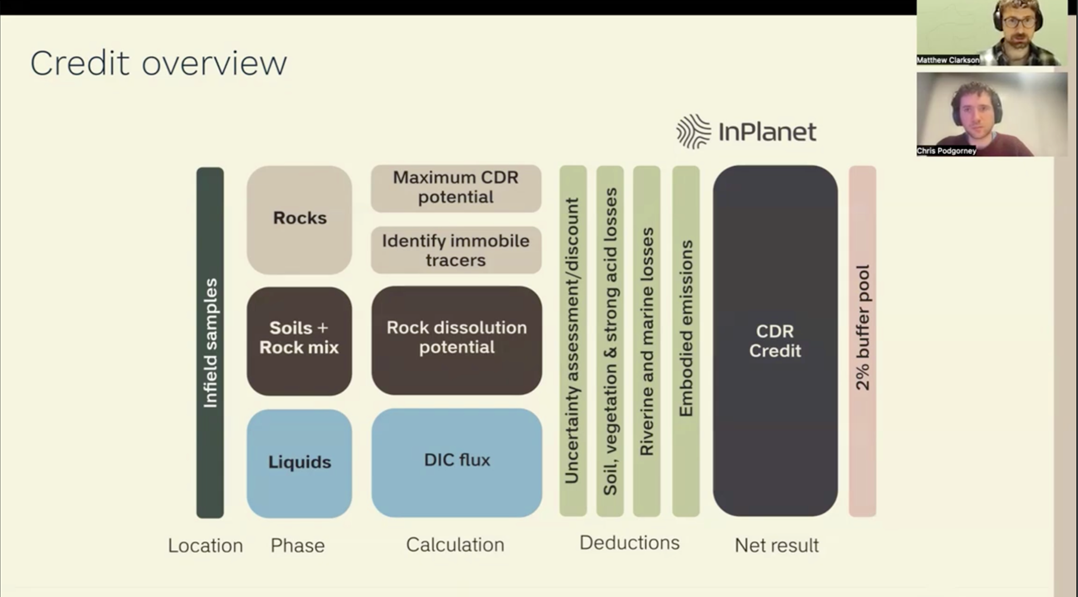A new milestone for Enhanced Weathering (EW) to play a significant role in large-scale carbon dioxide removal (CDR) while delivering co-benefits to agriculture and soil health. During this webinar hosted by Chris Podgorney, Head of Product at Isometric, Dr. Matthew Clarkson, Head of Carbon at InPlanet, explores how the issuance of these credits raises the bar for quality. What sets them apart is their incorporation of the latest scientific advancements in enhanced rock weathering. These credits are also backed by academic consensus. The carbon credits webinar also explores the operational feasibility of conducting rigorous Monitoring, Reporting, and Verification (MRV) in Enhanced Weathering (EW).
The issuance of these credits sets a precedent for MRV of this innovative climate solution. In this webinar, Dr. Clarkson and Chris Podgorney discuss the process, challenges, and scientific rigor behind these credits in depth.
Dr. Clarkson, a key figure in this initiative, provided an overview of the journey from initial research and funding rounds to the final issuance of verified credits. He noted:
“We’ve undergone our pre-seed and seed round funding to a total of about five and a half million euros and then benefited from momentum to get pre-purchase contracts from catalytic buyers like CarbonX, Shopify, and Climate. In 2024, we released our first scientific peer-reviewed paper, a review of different measurement approaches for enhanced weathering, and here we stand today with the first certified credits on the market.”
This achievement was supported by InPlanet’s team of 40 individuals across 16 nationalities. Remarkably, 40% of the team hold PhDs, highlighting the scientific rigor underpinning their work.
The actual project site, a 1200-hectare sugarcane plantation, was designed using a control and treatment model. This design ensured rigorous scientific comparisons. Clarkson elaborated:
“We’re looking at a site where about 20% is a control area. The control, outlined in pink, received no rock powder, while the treatment area had a carefully measured application rate of 10.6 tons per hectare. This approach ensures we can isolate the effects of rock powder application.”

From a scientific perspective, one of the biggest challenges was ensuring accurate tracking of rock weathering. Dr. Clarkson highlighted the decision-making process behind selecting neodymium as an immobile tracer:
“We started with three different options and had to analyze their statistical significance. In the end, neodymium checked all the boxes, providing consistency between field application records and operational logs. This level of precision is critical to maintaining the integrity of the credits.”
Verification and trust In carbon markets
Verification is key to ensuring trust in carbon markets, and this project followed a stringent process. Dr. Clarkson explained:
“Everything we do is based on in-field measurements. There are no models or experiments, just direct field sampling. We assess three main phases: rocks, soils, and liquids. By measuring how much calcium and magnesium are released from the rock powder, we can calculate the actual carbon removal.”
Furthermore, rigorous discounting was applied to ensure conservative credit issuance. We credit below the mean to bring a conservative attitude to the data. We also deduct operational emissions from sourcing, crushing, transporting, and spreading the rock powder. The net result is a verified CDR credit. One of the most exciting revelations was the 20-30% increase in sugarcane yield. Dr. Clarkson noted:
“The farmer was thrilled. He came up with a printout showing the yield increase. Beyond that, the ability to extend sugarcane productivity by an additional year before replanting is a game-changer for agricultural economics.”
Despite the successes, the team acknowledged areas for improvement. Biomass uptake was higher than expected, absorbing 20% of the entire carbon claim. This is a positive outcome from an agricultural perspective but requires refinement in our modeling to better quantify its impact.

Implications for the broader market
Clarkson reflected on what this achievement means for the broader CDR market:
“A year ago, people said EW was too complex to track. Now, we’ve demonstrated it can be done within a verification framework. This milestone represents a tipping point. To reach the scale needed by 2050, we need exponential growth, not linear solutions. Having a verified standard unlocks that scale.”
With the next version of the weathering protocol (v1.1) forthcoming, and increased industry interest, the future of Enhanced Weathering as a carbon removal pathway looks promising.
The issuance of the world’s first verified Enhanced Weathering credits is not just a scientific and operational milestone. It represents the maturation of a novel carbon removal solution with real-world impact. By combining scientific rigor, practical implementation, and third-party verification, this initiative has laid the foundation for a scalable and trustworthy approach to Enhanced Weathering.
“This is just the beginning. We have a roadmap, a blueprint, and we’re ready to scale. The science will advance, verification methods will evolve, but the foundation has been laid.”
The success of this project paves the way for broader adoption of Enhanced Weathering in the carbon market. It offers both climate benefits and agricultural co-benefits. As industries seek reliable carbon removal solutions, Enhanced Weathering is now firmly positioned as a verified and scalable pathway toward a sustainable future.
Replay available here: